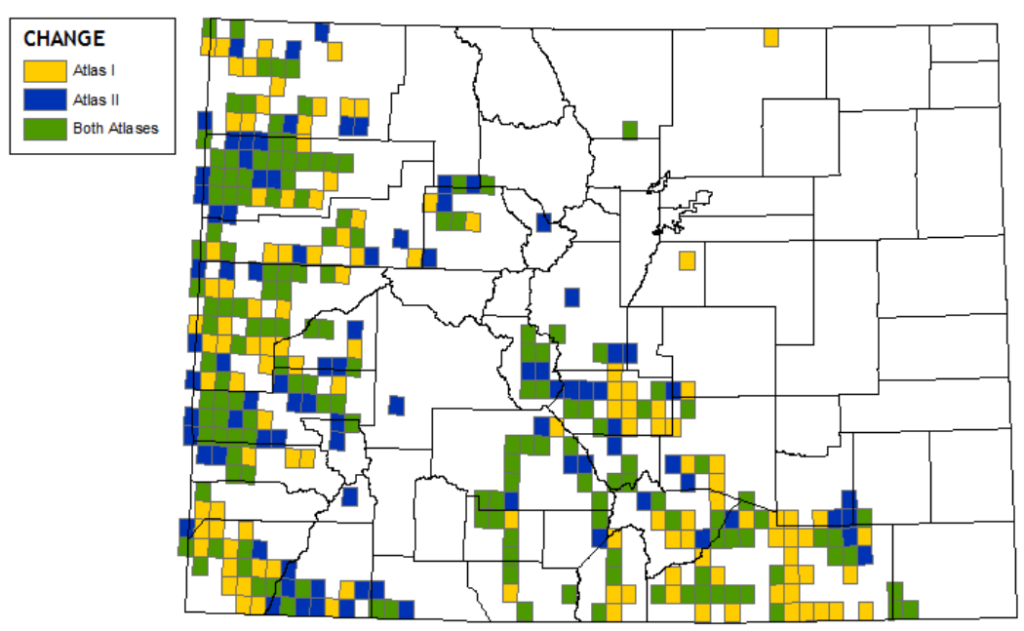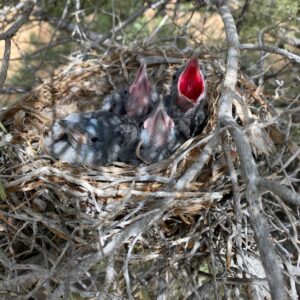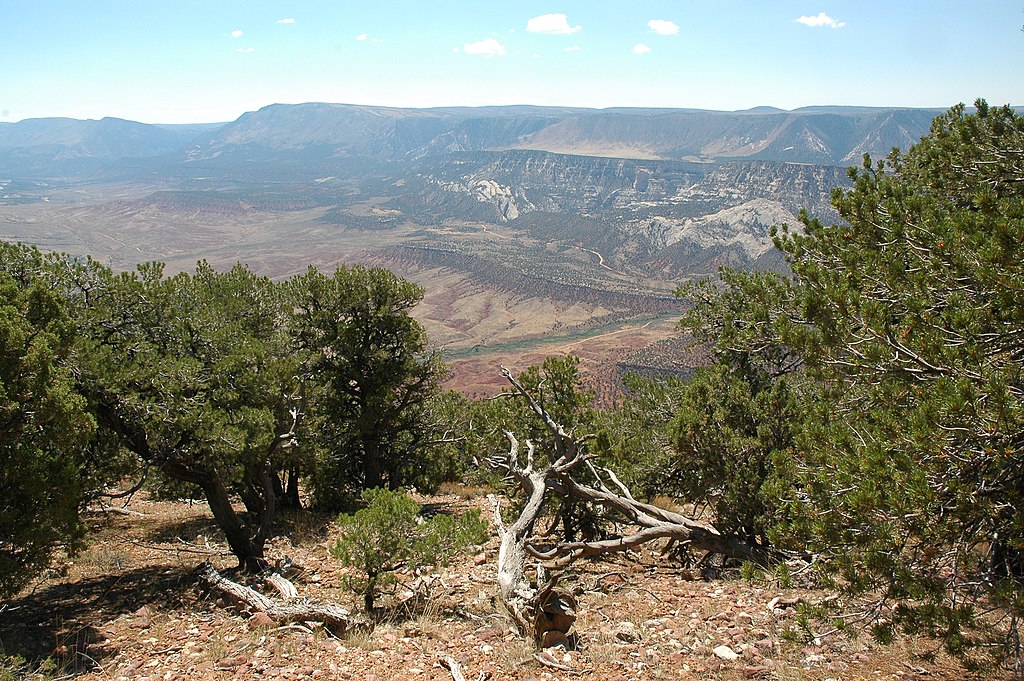Pinyon Jays are iconic, but declining, members of the pinyon-juniper woodland community across the intermountain west, including Colorado. Colorado Field Ornithologists is collaborating with Great Basin Bird Observatory and other partners across six states on the observatory’s Pinyon Jay Community Science Project. CFO seeks your assistance collecting data across the state.
How Can I Get Involved?
Key to this project is having volunteers out in the field collecting & recording data. This can even be done while you are doing other types of outdoor activities like birding, camping, or hiking. All you need is a smartphone!
You don't have to be an expert birder to help. Community scientists play a critical role in gathering crucial data on a scale not otherwise possible!
- Join Great Basin Bird Observatory’s data hub by creating a free account with Esri. Append “_CFO” to your username, so that we can add you to the Colorado Pinyon Jay Monitoring Group. Username example: “PeterPinyon_CFO. Create your account.
- Download the free ArcGIS Survey 123 app from Esri on your smartphone (available at your favorite app store).
- Log in using your GBBO Hub username and password.
- Read the short protocol for how to use the app to collect and enter data (linked below).
- Read the short protocol on how and where to survey Pinyon Jays - please note that as of December 2022 this document is focused on Nevada. Details for other portions of the western US will be added in 2023 (linked below).
- Go out and survey! Record your sightings and, importantly, lack of any sightings. You can survey anytime, in any pinyon-juniper woodland or adjacent areas.
Why Map Pinyon Jay Habitat & Activity?
Pinyon Jays have been declining in population range-wide. From 1967–2015, population levels fell an estimated 83.5%. In 2022, Defenders of Wildlife petitioned the U.S. Fish and Wildlife Service to have the species federally listed as threatened or endangered species, triggering a 90-day review period.
Declines may be linked to habitat conversion but research suggests that long-term drought, increasing temperature, and other climatic shifts are leading to pinyon pines that produce fewer nuts. The birds seem to be ranging further from historic sites and may be relying more heavily on other food sources such as juniper berries and insects.
Critical to any future management plan for the species will be data on how the birds use their pinyon-juniper habitat, yet there is little current information on that usage. Because of their patchy distribution on the landscape, these pine nut specialists don’t lend themselves to traditional point count monitoring methods.
In Colorado, Colorado Parks and Wildlife (CPW) has been conducting occupancy surveys within suitable habitat for Pinyon Jays and their breeding colonies since 2019. They have been doing intensive research at 23 breeding Pinyon Jay colonies to assess site fidelity, map colony extent using old and active nests, determine nest and fledging success, and evaluate potential threats to that success. They have also been coordinating with the Bureau of Land Management and the United States Forest Service to conduct surveys to find colonies within proposed woodland treatment areas in order to avoid colonies or to prescribe treatments that are more beneficial to pinyon jays. CPW is an active member of the Pinyon Jay Working Group.
Great Basin Bird Observatory has been conducting research on Pinyon Jays with partners for many years. The Pinyon Jay Community Science Project, coordinated by the Observatory, is attempting a comprehensive survey of habitats that Pinyon Jays use throughout the year across the western US. The project enlists volunteers as community scientists to monitor habitat usage and document Pinyon Jay behavior.
Once you sign up, you can collect data whenever you are out birding or make a special trip to explore a new part of the state!
Pinyon Jay Biology
The Pinyon Jay (Gymnorhinus cyanocephalus) is an iconic bird of the intermountain west and was once common throughout the Pinyon-Juniper woodlands of Colorado, Nevada, southern Utah, northern Arizona, and northern New Mexico. A communal species, their diet is comprised largely of pinyon pine nuts. As a result, the species can be quite nomadic in pursuit of this favored food.


Did you observe Pinyon Jay breeding behavior?
If you observe Pinyon Jay breeding behavior between February 14 – May 25, CPW would like you to share that information.
- Please contact CPW's Liza Rossi and Amy Seglund.
- Provide the following information in your email:
- location, as a UTM coordinates
- the types of behavior observed. Please use the behavior codes in the PDF that can be downloaded here.
Important: If you document breeding behaviors in an area, please immediately leave the area and do not disturb breeding birds. Birds will readily abandon nests if disturbed and you can inadvertently attract predators to a colony.


Related Events
Spring/Summer/Fall 2023 - CFO plans to lead field trips to potential Pinyon Jay habitat to collect data while exploring these locations. Regularly check on upcoming events for new trips. CFO Upcoming Events.
April 10 & 11, 2023 - Two 30-min introductory sessions by GBBO’s Outreach Biologist Ned Bohman. Part 1 (April 10) will cover the basics of Pinyon Jay biology and the history of Great Basin Bird Observatory’s Community Science Initiative. In part 2 (April 11th) Ned will cover the specifics of data collection and how to use the data entry app Survey1,2,3; followed by time for questions and discussion.
February 8, 2023 - Amy Seglund and Liza Rossi from Colorado Parks and Wildlife discussed how to identify pinyon jays and their natural history, then how community scientists can assist CPW with survey efforts. They will also provided a summary of current CPW research and monitoring of the species. Watch it on YouTube. Download the PDF of the slide presentation.
December 15, 2022 - John Boone the Pinyon Jay Community Science Project lead spoke about the project, the importance of Pinyon Jays, and how to participate. Missed this presentation? Watch it on YouTube.
Identifying Pinyon-Juniper Woodlands
Additional information on where to survey in Colorado will be added soon.

Where have Surveys Occurred
Surveys have been conducted in Colorado, Nevada, Utah, Arizona, and New Mexico. Join us to add surveys in Colorado in 2023 and 2024. For up-to-date survey locations, please visit the Results page of GBBO's Pinyon Jay Community Science Project.




